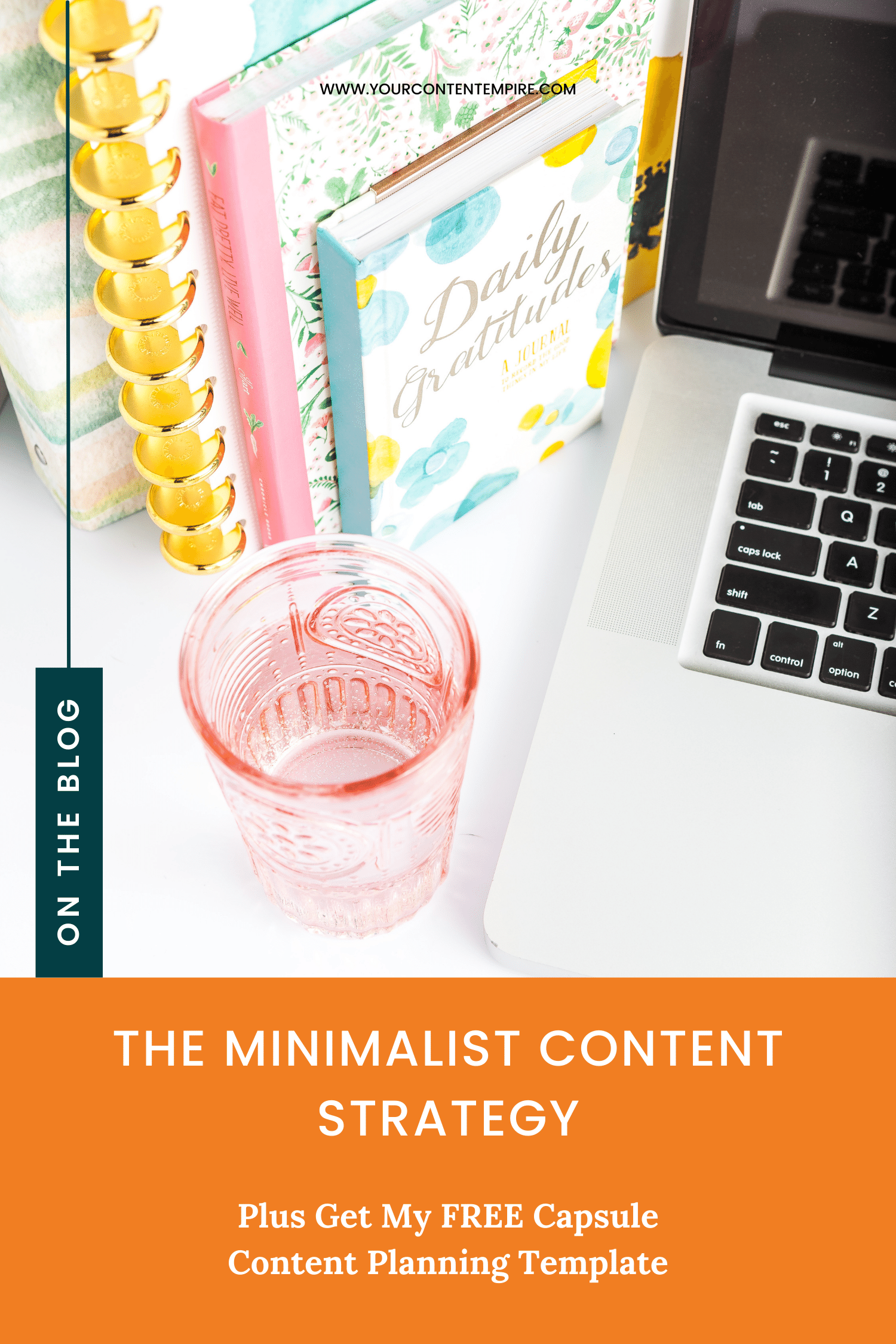The Minimalist Content Strategy Table Of Contents – Jump To:
What is the Minimalist Content Strategy?
Why the Capsule Content Method Works
How to Create Your Capsule Content Collection
What Happens After You've Completed Your Capsule Content Collection?
There's a question I seem to be getting more and more often, and that is: as a business owner, should I keep creating new blog posts for years on end?
Consistency is a make-or-break trait when it comes to succeeding in business, and that's often interpreted as needing to be consistent with blogging and content creation. This means, if you're blogging on a weekly basis, you could be adding up to 52 new posts every single year, and after three years, you'll be staring down the barrel of 150+ posts in your content bank and on your blog.
The question to ask yourself as a business owner is: are there 150+ topics that you feel relate to your offer and that you can talk about really well? Because at some point it might feel like you're starting to run out of topics or things to talk about, or at least like you've already covered all of the important things.
And would you rather:
- Produce a lot of content at a surface level, OR
- Focus on a few key topics and do those really well?
It comes down to this. Is there an endpoint to content creation or do you keep going no matter what, in the name of consistency?
I'd like to invite you to begin looking at your content as a body of work—a collection of ideas related to your signature process that represent what you do as a business.
Based on years of experience producing content for my own business and for clients, I’ve concluded that there is a natural end to the content creation process. Not only that, I’ve developed an approach that can be even more profitable—both from a time and money perspective—than grinding out new posts week in and week out.
In this post, I'm introducing you to my minimalist content strategy and how you can use the capsule content method to simplify your content, cover essential topics, improve ROI and serve your audience at the highest level possible.
What is the Minimalist Content Strategy?
The Minimalist Content Strategy is based on creating a capsule content which is a collection of 12 core blog posts that you have around a single offer or offer type.
For example, if you sell bookkeeping services, your capsule content collection would be all of the posts about your bookkeeping process and that service itself.
Or, if you’re a product-based business and you sell handmade jewelry, you could create a capsule content collection around your handmade jewelry. You might even have a few different collections, one for each of the specific types of jewelry you create.
And don’t just limit yourself to thinking that this only works for written blog posts because this strategy works whether you’re a video blogger or podcaster too. The only “rule” is that you add each episode or video to the blog section of your website with some sort of written summary, show notes or transcript.
My capsule content method includes 12 core posts around an offer, based on specific topics, including:
- Typical problems your ideal audience has
- Typical goals your ideal audience shares
- How your offer works (AKA your signature process)
- Showcasing the benefits of your offer
- A context post that shows how your offer fits into a bigger picture or system
(We'll get into exactly how to choose these topics for your posts in the How to Create Your Capsule Content Collection section.)
These 12 core posts represent the only posts you need to build an audience around an offer and convert them into paying customers or clients. As we’ll see below, you can stretch as far as you need them to in terms of generating sales and growing your audience.
What I love most about the capsule content method is that it truly is a minimalist, quality-over-quantity approach to content. Unless you're either over-the-moon in love with content creation or you're a blogger first, you don't need to be creating blog post upon blog post upon blog post… leaving you with a lot of time left over for the things that matter most to you in your business and life.
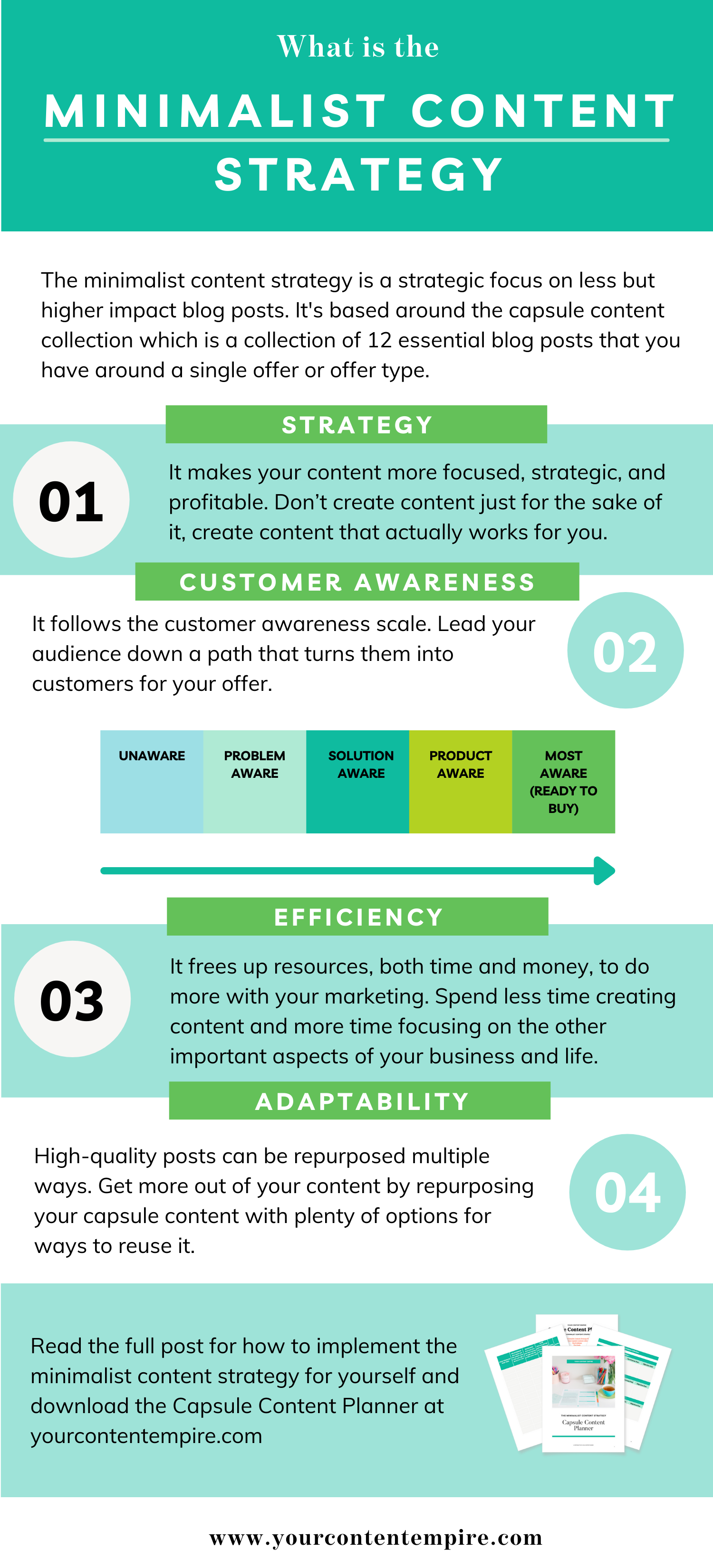
Why the Minimalist Content System and Capsule Content Collection Method Work
There are a lot of reasons why the capsule content method is such a powerful new strategy—one that actually gets you results without buying into the endless 24/7 content creation grind.
Here are my top four reasons why the capsule content method works.
1. It Makes Your Content More Focused, Strategic and Profitable
With the capsule content method, you plan your posts around your offer, rather than coming up with random topics and later having to figure out how to connect them. This means your posts are naturally better aligned to your paid offers.
As a business owner creating content, the end goal always has to be making sure that you’re building an audience of people who are actually potential clients and customers, even if it’s a smaller audience. It doesn't do you any good to have a ton of people on your email list if they aren’t going to be interested in your product or service.
Strategic content will attract and nurture the right audience for your offer and help build your business.
2. It Follows the Customer Awareness Scale
Eugene Schwartz came up with these five levels of customer awareness:
- Unaware
- Problem aware
- Solution aware
- Product aware
- Most aware
This capsule content method is designed with these five levels of awareness in mind. You’re creating content specifically for folks who are problem aware, solution aware or product aware. That way you can roll your content out in this order, so you make sure that you’re getting the right content to the right people at the right time, based on where they are in these five levels of customer awareness.
This is a much better way for us to move somebody to the next stage of awareness than just putting out a bunch of random content.
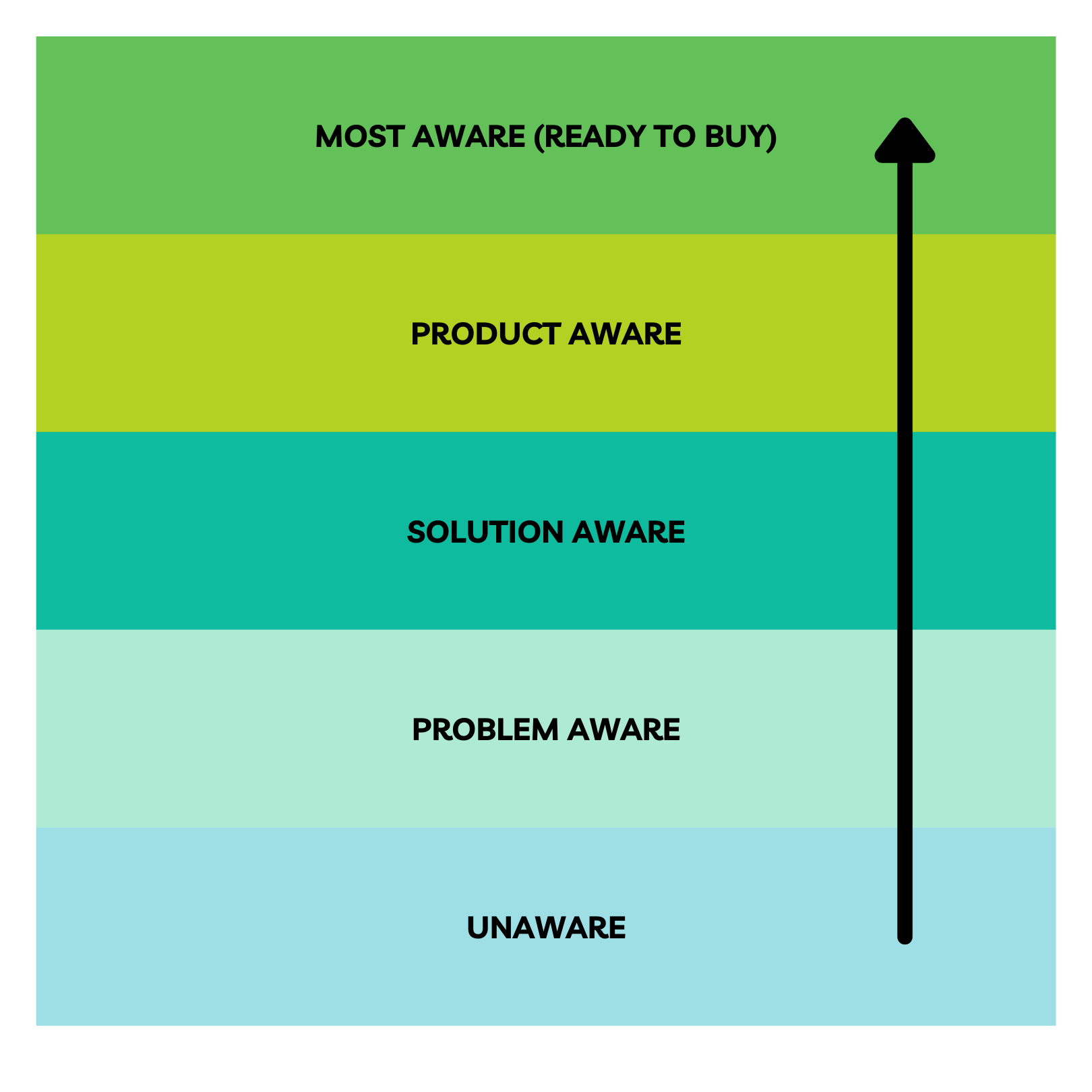
3. It Frees Up Resources—both Time And Money—to Do More With Your Marketing
When you buy into needing to create content every single week, it can eat up a lot of time in your calendar, even if you’re batching your content as efficiently as possible.
The capsule content method has you create 12 really great blog posts for each of the main offers in your business. You want to make sure that if you have three distinct offers, you're creating a different capsule content collection for each offer.
And once you're done creating those 12 great blog posts, you don’t need anymore. When crafted strategically, those 12 blog posts will move people along the customer awareness scale towards your offer.
This is going to free up all of that marketing time in your calendar that was previously allocated for creating new blog posts. You’ll then be able to use that time for other marketing activities you know are important—stuff that allows you to be more proactive in your marketing, like:
- Pitching collaborations
- Pitching podcasts
- Putting together sales events and campaigns
And when it comes to social media content, each of those 12 great blog posts in your capsule content collection will also include a suite of promotional copy and promotional images. So you won’t need to go back to the drawing board every single time to create those from scratch, either.
4. High-quality Posts Can Be Repurposed in Multiple Ways
Because you’re focused on creating 12 high-quality blog posts, rather than a bunch of so-so posts, you’re going to be creating content that people actually want to read/watch/listen to and get a lot out of. Nothing is worse than clicking through on Pinterest for what sounds like a really great blog post, and then finding that it has maybe two to three paragraphs that are full of fluff and not helpful at all!
That's what you’re going to avoid with your content by leveraging the capsule content’s quality-over-quantity ethos. A benefit of this method is that juicy, high-quality posts can be repurposed in so many different ways, such as:
- Social media content
- Freebies
- Presentations
- Guest posts
- Interviews
- Workshops
- Signature talks
- Podcast interviews
Juicy posts have a lot more meat in them, and that gives you more opportunities for repurposing them into other types of content.
How to Create Your Capsule Content Collection
There are three main phases to implementing the capsule content method (AKA the minimalist content strategy) for yourself. These include planning, creating and sharing your capsule content blog posts.
Planning refers to designing the strategy behind your capsule content collection. This includes deciding things like:
- Which offer you are building this campaign and collection around
- What topics you’re going to write about for your 12 capsule content posts
- What your creation roadmap is going to look like (what order you’re going to tackle these posts in and what order you’re going to share them in)
Creation refers to preparing the actual writing, filming or recording of your 12 capsule content blog posts.
And sharing refers to distributing your capsule content, either in their original blog post form or repurposed into other formats and types of content.
Let's go through each of the three main phases in more detail.
Phase One: Planning Your Capsule Content
The first step is to plan out your capsule content. You want to plan before you dive straight into creation so that you can make sure you’re approaching your posts strategically and intentionally. You want to choose the best topics and think about how each post relates to the others.
This is only possible when you plan with the full picture of your capsule content collection in mind, rather than just tackling one post at a time.
I see a lot of business owners get into trouble when they create their editorial calendar by choosing one post topic at a time. Before they know it, they have a bank of content that is not only not strategic but also doesn't work together to support their main business objective.
At the end of the day, the objective is to build an audience for your products or services and turn them into paying customers or clients.
Here are the three steps to planning out your capsule content collection.
Step One: Decide on an Offer
So what is the offer that you’re going to be creating this capsule content collection around? What should you do if you have multiple offers?
If you have multiple offers—and a lot of businesses at this point do—you want to decide whether your offers are related enough that they can be covered by the same capsule content collection (meaning that they generally solve the same problems), or if they’re too different.
For instance, in my business, I have
- A sales funnel package on my agency side, and
- A course on my Your Content Empire side
Yes, the course deals with sales funnels, but it also does content systems and content strategy. So in my case, these two are pretty different, and I would have a different capsule content collection for each one.
You might find yourself in a similar situation. If you have multiple offers that solve different problems and maybe even require slightly different audiences, you want to decide on which one to start with.
There are a few factors that you can use to make this decision.
- First, you can choose the offer that you would prefer your audience starts with. Do you have an intro offer or something that they should have in place first, before proceeding on to your other offers?
- Second, is there a breadwinner offer in your business—an offer that makes the majority of your revenue and your bottom line? If that is the case, focus on that offer first. It’s going to have a more positive return on investment a lot quicker than if you’re doing an offer that currently isn’t bringing in a lot of money, whether because of a price point issue or because it's just not as in demand as the other offer.
- Third, which offer do you really want your business to be known for? If you have a signature offer, choose that one and design that capsule content collection first. You're going to have a lot of passion that you can pour into creating this first capsule content collection. Then, you can take everything you learned and use it for the next offer.
Step Two: Map out Your Capsule Content Topics
The 12 posts in your capsule content collection will cover specific topics. The first nine posts can be broken down into three groups of three:
- The first three posts cover or explore a problem that your ideal client or customer has (one that’s related to your offer).
- The next three posts are around the goals that your ideal client or customer might have, again related to your offer.
- Then, the next three posts are around objections that your ideal client or customer might have when it comes to your offer, or why they might think that is not a great fit for them. You want to create a piece of content that explores those objections so you can preemptively resolve them.
Your last three posts are individual posts:
- The first one you want to do is a process post. You want to create a post that explores your signature process or how your offer works, especially if it's a product-based business.
- Number two is a showcase post. You want to showcase how your product is used by customers, or how your service or digital product or program has helped transform the life or business of your ideal client or customer. If you don't have any clients or customers yet, you can still do this post—just focus on yourself. Oftentimes you are your own client, your own customer first, and that’s how you’ve become informed enough to create your product or service.
- The final post is a context post. You want to think about how your offer fits into a bigger picture or system, and what its role is in relation to the other parts of that system.
I'm going to go through a few examples here of different problems, goals, objections and processes. I’ll start with a product-based business.
Say, for instance (to go back to my earlier example) that you’re selling handmade jewelry.
- Some of the problems that you might tackle are questions like: How do I store my jewelry? My jewelry box is completely disorganized—how do I organize it? I feel like I’m never wearing that necklace or those earrings, so how do I pick pieces that compliment my outfits? It always feels like my jewelry’s a huge mess. How do I keep it clean?
- Some of the goals that your clients or customers might have are how to elevate an everyday outfit or how to change up the look of an outfit with a statement piece of jewelry.
- For the objection post, it might be something around the price, and making the case for why to invest in a few key pieces rather than a bunch of jewelry that will never be worn or won't stand the test of time.
- The showcase post might be showcasing a particular collection or certain designs. Or, it could also be the different outfits that they're used with or different scenarios or events where your jewelry could be worn.
- The process post could go into a behind-the-scenes of how you design and create a piece of jewelry from start to finish.
- The system that the jewelry fits into for this context post might be a person’s wardrobe. How does the jewelry relate to other pieces and accessories?
When it comes to a service-based business, I'm going to go with a bookkeeper example, as I did previously.
- When it comes to problems, you want to think about things like: My receipts are always a mess—how do I organize them? What expense categories do I need to set up, because I have no idea where to start?
- Three goals might be things like using a bookkeeper to make more money, understanding how to hire a bookkeeper, and getting organized with your finances.
- When it comes to objections, it might be things like: How do I afford a bookkeeper? How do I choose a good bookkeeper?
- A process post could be something like the signature process included in your package, and a little bit about what you do in each step.
- For your showcase post, you could talk about clients that you've worked with and the benefits that have come from your work together.
- The context post, in bookkeeping, might be about where bookkeeping fits into the overall financial, admin system or CEO system.
Now that you have an overview of how to pick your blog post topics, I'd like to invite you to sign up for my FREE capsule content collection mapping workshop (and the free capsule content planner). We'll go through how to brainstorm different ideas and then how to select the best one. By the end of it, you’ll have a roadmap to follow for your capsule content collection.
Step Three: Decide How You're Going to Tackle Creating Your Posts
Now you have your list of 12 core blog posts. How are you going to tackle them?
One at a time? Batch them? A couple this month, a couple next month?
Regardless of which method makes the most sense for your business, it’s important to make a plan for how you’re going to get these blog posts done. Generally, what you want to do is return to how the capsule content method mirrors the customer awareness scale.
Here’s your first checklist of posts:
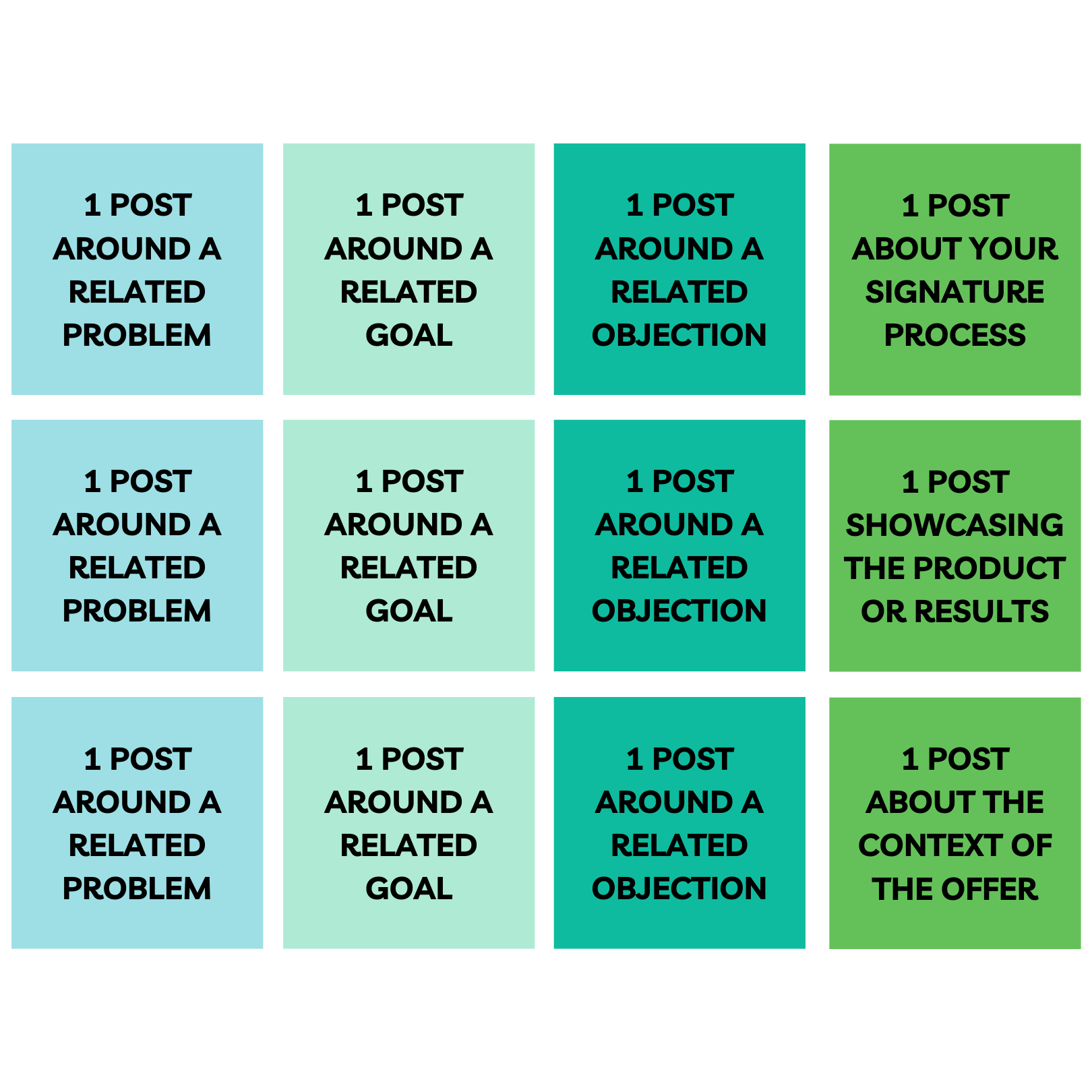
And I just want to remind you that even if you're going to create these posts one at a time, I definitely recommend planning all of the posts out so that you know what's coming next and how each one fits into the overall capsule collection.
So those are your three steps for planning your capsule content—and make sure to download the capsule content planner!
Phase Two: Creating Your Capsule Content Posts
What differentiates a capsule content post from your general run-of-the-mill blog post, podcast episode or video blog?
Here are four key features of capsule content:
- Because we're focused on this less is more, quality-over-quantity approach, these capsule content collection posts are going to be higher quality. This means that, in general, they're going to be probably a bit longer and a bit juicier, usually at least a thousand words if written. If it’s a video or a podcast, they will be likely paired with high-quality show notes and a transcript. You can afford to invest in these 12 posts in terms of time because you're not creating posts endless. There is an endpoint for you. So really invest your time and energy into making these 12 standout pieces of content.
- Another feature is that they are visually appealing and easy to digest. On top of being well written or recorded, they're also supplemented with some visuals, such as diagrams that explain and display different pieces of the blog posts.
- Because we have reverse-engineered the topics from your paid offers, a third feature of capsule content posts is that they fit within your funnel for your offer. The call to action is to sign up for your funnel freebie, AKA the doorway into your sales system for the paid offer that it relates to. You’re building a content marketing selling machine, so you need to make sure that the next step gets clients or customers one step closer in that buying journey.
- If you’re doing podcast content, your capsule content posts are usually going to be a solo episode, even if you generally do interviews with other people. This way, you can showcase your ideas and not somebody else's. Interviews can be great accessory pieces of content and a great way of amplifying your message, but for these capsule content posts, we want to make sure you feature your ideas.
You can use this as a checklist to check your blog posts, videos or podcasts after you've created them.
So what’s the process for actually creating these posts?
I’ll go through my recommended process, but I do want to note here that this process can vary depending on the type of content you're creating, if you're repurposing something, or adapting an existing blog post or video.
Pro tip: One of my favourite ways for creating these really high-quality blog posts is my DIY content interview method process. Check out that blog post for a walkthrough on how I use this content interview process to create high-quality blog posts.
Now, here is the four-step process I recommend for creating those capsule content posts.
Step One: Detail Your Outline
Get as detailed as possible. Create a very detailed outline so that it takes care of a lot of the writing for you. You really want to organize your thoughts, and here is where you might want to bust out that paper and pen again. Studies show that we are more creative and have more idea generation when we write things by hand versus typing them.
When outlining, make sure to organize everything in a way that makes sense. So if you're doing a how-to post, you should:
- Introduce the concept and why it's important
- Give the steps in a lot of detail and talk about why they’re important
- Summarize all your steps with your call to action
I recommend spending at least as much time outlining the post as you do actually writing or recording it. The more time you spend on that outline, the less time you're going to need to spend actually figuring out the right words to say.
Step Two: Draft or Record Your Post
Step number two, however, can’t be avoided. You need to draft or record that post.
In this step, you're going to take your detailed outline and you're going to expand upon it. You’re going to actually go and draft that written blog post, record that video or record that podcast episode.
Now, you might be using my content interview process and having a friend, a team member or a partner interview you. Or, you could be locking yourself away and just typing your blog post out. You could also be repurposing something, or just doing a solo podcast episode. Whatever works for you—block off time for yourself, set a deadline, and get it done!
Step Three: Edit
I'm a big believer that the magic in content creation really comes through the editing process. So you definitely want to take some time here and do multiple passes through your writing, video or show notes to make sure that everything is in tip-top shape and ready to go on your website.
I have a four-phase editing process that I rely on religiously.
- I do an editorial review and clean up. As I go through, I make sure everything flows and makes sense. I check spelling and ideas and reorganize information.
- Pass two is editing for brand voice. I go through and make sure that it sounds like me, and I add in pops of personality wherever possible.
- The third pass I do is for formatting and emphasizing the right information. I go through each section and I ask myself, what is the most important piece of information in this section and how can I call attention to it? Whether that is bolding it, italicizing it, making sure it's on its own line, or highlighting it—how can I make it stand out? I also ask, how can I break this up so it's a little bit easier to read and consume? This can involve adding in subheaders and bullet-point lists and shortening sentences and paragraphs. I am the queen of the run-on sentence, which was a huge sticking point between my MA thesis advisor and me. This pass is essential, at least as far as I'm concerned because formatting and structure are crucial for readability, especially for long, detailed posts. You want your audience to be able to absorb your content effortlessly.
- In pass number four, I like to set aside the post for a bit (a few hours or a day), and then come back and do a final pass-through and see if there are any final changes that I want to make in each of the sections.
By the time I get through that four-phase editing process, I'm pretty darn happy with how the post has turned out.
Step Four: Add Polish, Pops and Visuals
Go back through and figure out where you can add a diagram, gif, pull quote, or another kind of visual that supports your point. Where can you really make things pop? Step number four is really just to bring all the pieces together and publish it and make it look really, really good.
Tip: Make a Freebie for List Building
Finally, I recommend—especially with those problem and goal posts—that you choose one of them and turn it into a simple freebie for list building. It’s going to go a long way in getting people into your sales system and into your funnel for your main offer.
What is the biggest problem that most people share? What is the biggest goal that most of your ideal clients and customers have? Turn those pieces of content into a roadmap or a checklist, and then turn it into a download that people can sign up for.
By jumping off the content you’ve already created, putting together a freebie is low-hanging fruit for your business.
Phase Three: Sharing your Capsule Content
You’ll find there are many, many ways to share your capsule content blog posts. Here are five of my favourite ways that you start working into your strategy right now.
1. Publish and Share Your Posts
At the end of the day, your capsule content posts are blog posts. The same ways that you're creating and sharing blog posts right now still apply and work. As you create each new capsule content blog post, publish it, promote it and drive traffic to it.
If you are in the capsule content creation phase, meaning that you haven't created all of your 12 blog posts yet, I recommend that you release them one by one, either weekly, bi-weekly or monthly. So publish them, have a social media campaign around them to drive traffic to them and make them your main event for that week.
I wouldn't recommend publishing more than one a week at a time as you're releasing them. Each of these posts is so good that you’re going to want to create an event around them and an opportunity for people to truly pause for a moment and consume them.
So pick one and release them one by one.
If you're finished with the creation phase, meaning that you've already created all 12 of your core blog posts and released them, you can go back and reshare them.
So your posts don't necessarily need to be new posts. You can go back and share them. People who've already seen them will appreciate seeing them again because they’re likely going to be at different points in their business and take away different things.
I know I can read the same book 10 times (for me, it's Playing Big by Tara Mohr, and I read it every single year). And even though I've read that book before, every time I read it, I take something new away from it and apply it in different ways. And the same is true with your content. By resharing it, you're going to give new people in your audience an opportunity to see it and love it and apply it as well.
When it comes to the sharing schedule, I covered that a little bit in the creation phase, but essentially what you're going to do is you're going to want to share it in a specific order.
You’ll create three groups of four blog posts (problem, goal, individual post, objection) that you'll rotate through. The goal is to avoid sharing two goal posts back to back, or two problem posts back to back. Instead, you want to make sure that you're sharing your content capsule posts in a series that follows the customer awareness schedule.
You can set up the sharing schedule that makes the most sense for you. Here are a few examples of how different schedules play out:
- Weekly: get through one group of four posts) in a month
- Bimonthly: get through one group of four posts every two months, or
- Monthly: get through one group of four posts in four months (you're basically going to have a year of content covered from just these 12 blog posts)
2. Repurposing Your Posts
The second way to share your capsule content is by repurposing it.
In a few weeks, I’m going to be hosting my brand-new repurposing challenge and I'm so excited to share it with you. To give you a teaser, here are some of the ways that you can repurpose these capsule content posts so that you can get a lot of mileage out of them.
- Turn them into social media posts. Because you’ve created really juicy posts, you’re going to be able to take out sections of them and turn them into social media posts. My method of repurposing capsule content blog posts is to turn each of them into at least 12 social media posts. I go through my method in the free challenge coming up
- Turn them into different formats. If you went through and created written blog posts, now, the second time through, you can film a video or a solo podcast episode for them. This will give people an opportunity to consume your content in different ways and you may reach people who prefer video content or audio content instead.
- Turn them into freebies. I mentioned this as a tip before, but turn those goal posts and those problem posts into roadmaps, checklists or processes. It's going to be a great little freebie for you to create other entryways into your sales system.
- Turn them into collaborations, such as guest blog post or a podcast interview where you teach people how to do X, Y, and Z. All of your speaking notes are right there in that blog post, which is fantastic.
- Turn them into presentations. If you want to participate in a summit, hold a challenge or host your own webinar, you can use one of your capsule blog posts as a jumping-off point for the content that is going to be in there.
- Turn them into products. This was actually one of the ways that I wrote my book, Your Content Rebellion—by pulling on different blog posts that I had created and turning those into the chapters. You might wonder why people would pay for content in a book format when they can read it for free, but people appreciate different formats and different ways of consuming content. I think about James Clear, who is the author of one of my favourite books, Atomic Habits. I recognize the majority of those chapters from the blog posts where I originally read them. Does that mean I enjoy it any less? No. It's just a different form of consuming the content and a different way to get the content. Each blog post could be a module in a course or a small digital product, or it could be something bigger like a book or a signature program.
3. Turn Your Posts into a Sales System
Earlier, I touched on the fact that you want to make sure each of your blog posts in this capsule content collection has a call to action that gets people into your automated sales system, AKA your sales funnel.
If you don't have a sales system already, what you can do is use one of the content capsule groups—problem, goal, how it works, objection—to form the backbone of the automated sales system that follows after someone signs up for your list. You would only need to add two to four sales emails that invite them to a special offer or a sales conversation.
4. Use My Forever Funnel Method
The fourth way that you can take it one step further is by using my forever funnel method.
If you want to put your content and your email marketing on autopilot, you can use the capsule contents groupings to send out your sales emails. Anyone who signs up starts on email one, even if they signed up two weeks after someone else.
By scheduling it so that each of these groupings goes out in an email week by week, people will be getting an email regularly from you, but you won’t need to remember to write and send an email newsletter week in and week out.
What's great about this is that if you’re sharing weekly and you have your 12 posts, that is going to cover a whole three months. Or, you could spread it out so that you do one of your groupings, then add a week or two of sales emails for your offer, and then go back to the weekly nurture emails. By doing it that way, you're going to be able to cover four and a half months of content completely on autopilot. Learn more about this method here.
5. Stacking
Finally, you can start adding additional capsule content collections and start stacking them.
If you have multiple distinct offers that require different capsule content collections, you can now start working on your next capsule content collection for the second offer, and then you can stack those two. This means that people go through the first one, and then they can go through the second capsule content collection as well, or as many as you create, and then you can go back to the beginning.
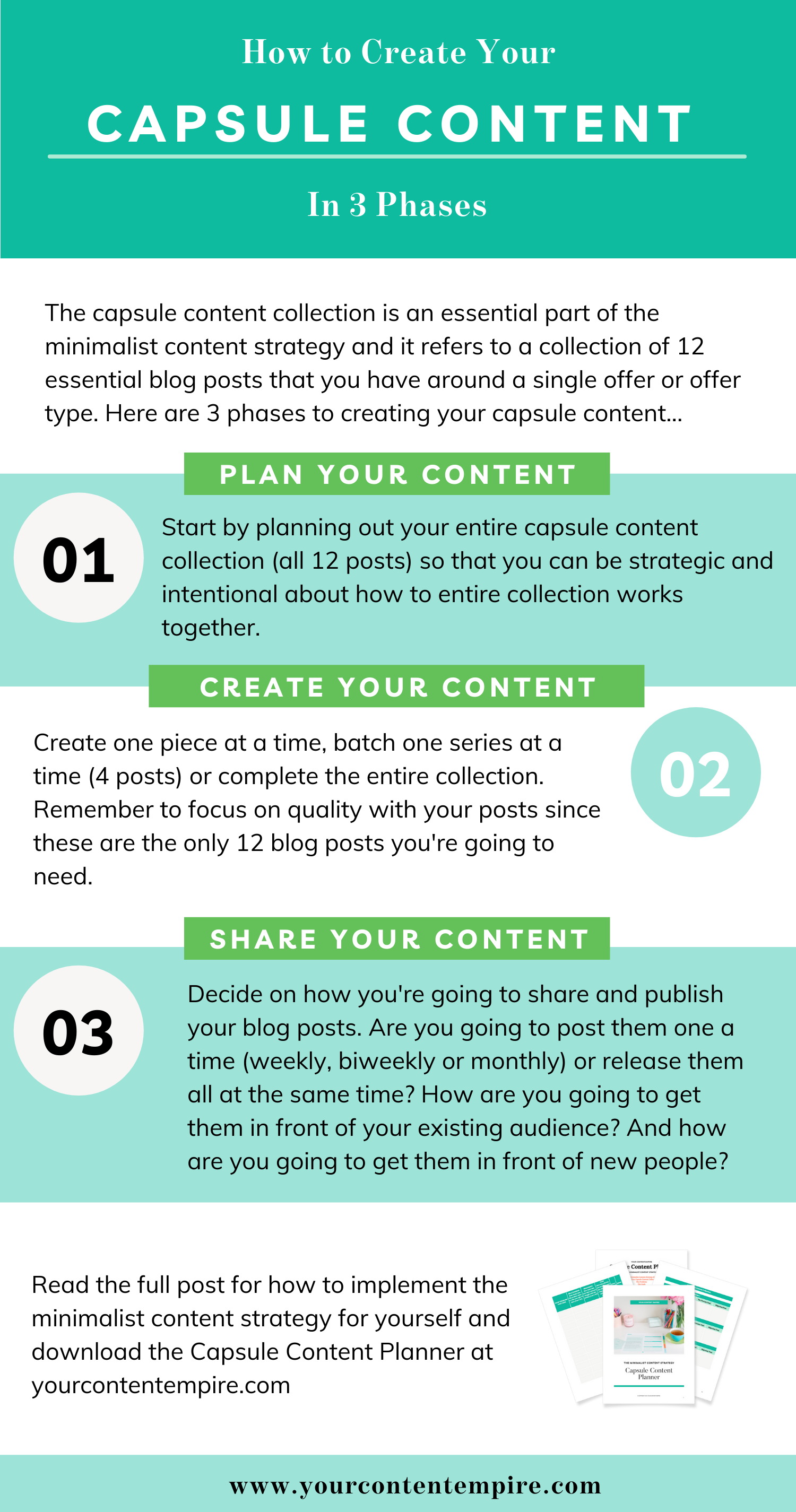
What Happens After You've Completed Your Capsule Content Collection?
A question I get a lot when I introduce the concept of the minimalist content strategy or the forever funnel method is: What happens after I am finished creating it? Am I just done creating content?
It’s as if it's such an unthinkable idea, that there could ever be an endpoint where you're not constantly creating new content!
There are a couple of ways that I like to answer this question
Number one, once you're finished creating your content, you want to make sure that you continue to share it and then reshare it. The whole idea here is to promote your content so that you can get it in front of new people as well as people who are already in your audience who haven't seen it in a while.
Remember that it is something incredibly valuable that you are sharing, and so it's not spammy. It doesn’t matter if people have seen it already—you can continue to promote it. Or you could repurpose that original piece of content into other formats, such as turning it into a video or a PDF or a podcast episode.
You have a lot of options. Once you have that base capsule content collection, you could mix and match it and repurpose it in a bunch of different ways.
Are there any scenarios where you would create new content once this has finished? I think that there are a couple of different scenarios where you might.
First, you would create a new capsule content collection. Yes, an entire collection, if you created a new offer or if you wanted to create it for another offer that isn't related. You could have like two to three capsule content collections for different offers and you can rotate through promoting them.
The other scenario where you would create new content is if you want to.
The minimalist content strategy is not meant to control you and say that you could never create content again; it is merely to give you the choice.
You don't have to create content. Once you've created these 12 essential blog posts, you can focus your time on other things, but that's not to say you can't, if you feel inspired by an idea, or if you want to create a new piece of content.
By all means, go ahead! In my own business, even though I have all of my core content created, I still write a new blog post from scratch every quarter with an idea that I’m really inspired by.
I get to be in the driver's seat of choosing when and if I create new content, as well as how I share it.
Start Creating Your Capsule Content
Now you have all of the information you need to begin creating your own capsule content including what it is, how to plan and create it, and all of the options you have for promotion and reuse post-publishing.
It’s completely up to you, but once you finish your capsule content you may never need to create more content again. This frees up time and energy to focus on the other aspects of your business that are important to you.
Remember to sign up for the Capsule Content Mapping Workshop (that comes with the free Capsule Content Mapping Planner!) to help you get started. I can’t wait to see the amazing content you’ll produce!


